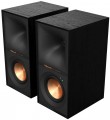Add to comparison |  |  |
|---|---|---|
| Klipsch R-50PM | Klipsch R-51PM | |
| Compare prices 3 | from £449.00 | |
| User reviews | ||
| TOP sellers | ||
| Main | Built-in amplifier. bluetooth. Sub-in. Phono stage. | Built-in amplifier. bluetooth. Sub-in. Phono stage. |
| Features | homemade | homemade |
| Mount | shelf | shelf |
Specs | ||
| Type | active | active |
| Number of channels | 2.0 system | 2.0 system |
| Number of speakers | 2 | 2 |
| Number of bands | 2 | 2 |
| Crossover frequency | 1.663 kHz | 1.663 kHz |
Power / frequency | ||
| Front | 60 W/channel | 60 W/channel |
| Maximum amplifier power | 140 W | |
| Total rated power | 120 W | 120 W |
| Overall frequency range | 55 – 20000 Hz | 68 – 21000 Hz |
Design | ||
| Design features | magnetic shielding phase inverter back horn design | magnetic shielding phase inverter back horn design |
Connectors | ||
| Inputs | RCA mini-Jack (3.5 mm) optical USB port | RCA mini-Jack (3.5 mm) optical USB port |
| Outputs | RCA | RCA |
General | ||
| Bluetooth | + | + |
| Remote control | ||
| Tweeter size | 25 mm | 25 mm |
| Woofer size (LF/MF) | 133 mm | 133 mm |
| Finishing material | MDF | MDF |
| Front speaker dimensions (HxWxD) | 35x18x27 cm | 34x18x23 cm |
| Weight | 11.2 kg | 9.6 kg |
| Color | ||
| Added to E-Catalog | september 2023 | november 2018 |